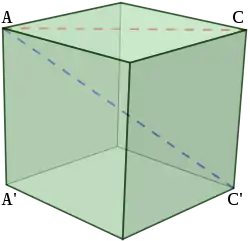Face diagonal
In geometry, a face diagonal of a polyhedron is a diagonal on one of the faces, in contrast to a space diagonal passing through the interior of the polyhedron.[1]

A cuboid has twelve face diagonals (two on each of the six faces), and it has four space diagonals.[2] The cuboid's face diagonals can have up to three different lengths, since the faces come in congruent pairs and the two diagonals on any face are equal. The cuboid's space diagonals all have the same length. If the edge lengths of a cuboid are a, b, and c, then the distinct rectangular faces have edges (a, b), (a, c), and (b, c); so the respective face diagonals have lengths and
Thus each face diagonal of a cube with side length a is .[3]
A regular dodecahedron has 60 face diagonals (and 100 space diagonals).[4]
References
- Gullberg, Jan (1997), Mathematics: From the Birth of Numbers, W. W. Norton & Company, p. 396, ISBN 9780393040029.
- Mullan, Edward C. K. (2003), New Maths in Action, Nelson Thornes, p. 220, ISBN 9780748765195.
- Messler, Robert W. Jr. (2010), The Essence of Materials for Engineers, Jones & Bartlett Publishers, p. 56, ISBN 9780763778330.
- Sutton, Daud (2002), Platonic & Archimedean Solids, Wooden Books, Bloomsbury Publishing, US, p. 55, ISBN 9780802713865.